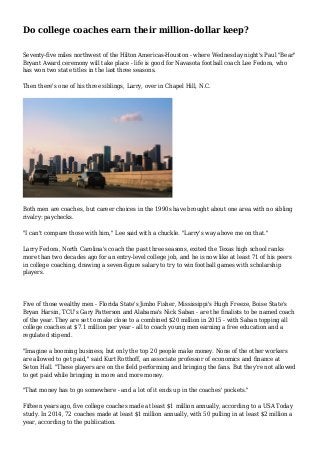
Do college coaches earn their million-dollar keep?
- 1. Do college coaches earn their million-dollar keep? Seventy-five miles northwest of the Hilton Americas-Houston - where Wednesday night's Paul "Bear" Bryant Award ceremony will take place - life is good for Navasota football coach Lee Fedora, who has won two state titles in the last three seasons. Then there's one of his three siblings, Larry, over in Chapel Hill, N.C. Both men are coaches, but career choices in the 1990s have brought about one area with no sibling rivalry: paychecks. "I can't compare those with him," Lee said with a chuckle. "Larry's way above me on that." Larry Fedora, North Carolina's coach the past three seasons, exited the Texas high school ranks more than two decades ago for an entry-level college job, and he is now like at least 71 of his peers in college coaching, drawing a seven-figure salary to try to win football games with scholarship players. Five of those wealthy men - Florida State's Jimbo Fisher, Mississippi's Hugh Freeze, Boise State's Bryan Harsin, TCU's Gary Patterson and Alabama's Nick Saban - are the finalists to be named coach of the year. They are set to make close to a combined $20 million in 2015 - with Saban topping all college coaches at $7.1 million per year - all to coach young men earning a free education and a regulated stipend. "Imagine a booming business, but only the top 20 people make money. None of the other workers are allowed to get paid," said Kurt Rotthoff, an associate professor of economics and finance at Seton Hall. "These players are on the field performing and bringing the fans. But they're not allowed to get paid while bringing in more and more money. "That money has to go somewhere - and a lot of it ends up in the coaches' pockets." Fifteen years ago, five college coaches made at least $1 million annually, according to a USA Today study. In 2014, 72 coaches made at least $1 million annually, with 50 pulling in at least $2 million a year, according to the publication.
- 2. In Texas, Charlie Strong at the University of Texas and Kevin Sumlin at Texas AM each draws $5 million annually. Saban, who has won four national championships (including one at LSU), was asked in 2012 by the CBS show "60 Minutes" if he believed he was worth $5 million, his annual salary at the time. "Probably not," he said, smiling. "But the other side of that is you have to look at what return has there been on that investment." It's not capitalism That's where the argument is made that the best coaches are, indeed, worth the investment. According to a recent study in the Wall Street Journal, 24 college football programs are worth at least $300 million, topped by Ohio State at $1.1 billion. And that was before the Buckeyes and coach Urban Meyer ($4.5 million annually, sure to soon balloon) won the national title Monday night with a 42-20 victory over Oregon. So are skyrocketing salaries - 11 coaches make at least $4 million annually - simply capitalism at full throttle? No way, according to Rotthoff. "Any organization that disallows payments to people is not any form of capitalism," said the professor, who specializes in the study of sports finances. "It's the antithesis. In a capitalistic world, the players would negotiate their own salaries. It's a regulated monopoly system." Spencer Nealy, a former Texas AM defensive lineman who wrapped up his college career two years ago, contends that a scholarship covering college costs is plenty for players no matter how much their coaches make. "We got to go to school for free," said Nealy, who earned a brief shot in the NFL and is now in private business around San Antonio. "We're ahead of the game coming out of college because we're debt-free. Coaches need these salaries because of the stress and lack of stability that come with the job. In 2010, we went to the Cotton Bowl, and everything was great under Mike Sherman. A year later, he was fired. That's crazy. "The coaches spend so many hours away from their families, too, and there's so much more to it than
- 3. just coaching football for them. There's a lot that comes with the job." Salary cap illegal For critics who believe the coaches could "get by" on much less, the concept of an NCAA salary cap is routinely kicked around as a solution. But a 1998 U.S. Court of Appeals ruling (Law vs. NCAA) determined that a salary cap restrains trade or commerce and is illegal via the Sherman Antitrust Act, the nation's declaration of free trade from 1890. "The NCAA has no role or input whatsoever regarding coaching salaries, and all personnel decisions are made by each respective school," NCAA spokesman Chris Radford said. That's where Rotthoff, the economics professor, said he can't figure the dynamic of the NCAA strolling hand in hand with free trade - at least concerning coaches' pay. http://www.chron.com/sports/college-football/article/Do-college-coaches-earn-their-million-dollar-kee p-6013481.php